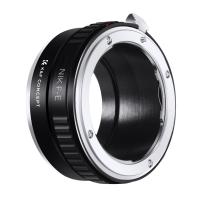Why Are Microscopes So Important ?
Microscopes are important because they allow us to see objects and organisms that are too small to be seen with the naked eye. They have revolutionized the fields of biology, medicine, and materials science by enabling scientists to study the structure and function of cells, microorganisms, and other tiny structures in great detail. Microscopes have also played a crucial role in the development of many scientific discoveries, such as the discovery of bacteria and the understanding of the structure of DNA. They are used in a wide range of applications, from medical diagnosis and treatment to the study of materials and the environment. Without microscopes, many of the advances in science and medicine that we take for granted today would not have been possible.
1、 History of Microscopes
Why are microscopes so important? Microscopes are essential tools in the field of science and medicine. They allow us to see objects that are too small to be seen with the naked eye, such as cells, bacteria, and viruses. Microscopes have revolutionized our understanding of the natural world and have led to many important discoveries.
The history of microscopes dates back to the 17th century when Antonie van Leeuwenhoek, a Dutch scientist, developed the first microscope. Since then, microscopes have undergone significant advancements, including the development of electron microscopes, which allow us to see even smaller objects at a higher resolution.
Microscopes have played a crucial role in many scientific discoveries, including the discovery of cells, the structure of DNA, and the identification of new species. In medicine, microscopes are used to diagnose diseases, study the effects of drugs on cells, and develop new treatments.
In recent years, microscopes have become even more important with the development of new technologies such as super-resolution microscopy, which allows us to see structures at the nanoscale level. This has led to new discoveries in fields such as neuroscience and materials science.
In conclusion, microscopes are essential tools in science and medicine. They have revolutionized our understanding of the natural world and have led to many important discoveries. With the development of new technologies, microscopes will continue to play a crucial role in advancing our knowledge and improving our lives.
2、 Types of Microscopes
Why are microscopes so important? Microscopes are essential tools in the field of science and medicine. They allow us to see objects that are too small to be seen with the naked eye, such as cells, bacteria, and viruses. Microscopes have revolutionized our understanding of the world around us, and they continue to play a crucial role in scientific research and medical diagnosis.
There are several types of microscopes, each with its own unique features and applications. The most common types of microscopes include optical microscopes, electron microscopes, and scanning probe microscopes. Optical microscopes use visible light to magnify objects, while electron microscopes use beams of electrons to create highly detailed images. Scanning probe microscopes use a tiny probe to scan the surface of a sample and create a three-dimensional image.
The latest point of view on the importance of microscopes is that they are becoming increasingly advanced and sophisticated. For example, new developments in electron microscopy have allowed scientists to study the structure of proteins and other molecules in unprecedented detail. This has led to breakthroughs in fields such as drug discovery and materials science.
In addition, microscopes are becoming more accessible to a wider range of people. Advances in technology have made it possible to create smaller, more affordable microscopes that can be used in classrooms and homes. This has the potential to inspire a new generation of scientists and innovators.
In conclusion, microscopes are incredibly important tools that have transformed our understanding of the world around us. As technology continues to advance, we can expect to see even more exciting developments in the field of microscopy.
3、 Microscopy Techniques
Microscopes are incredibly important tools in the field of science and research. They allow us to see and study objects that are too small to be seen with the naked eye, such as cells, bacteria, and viruses. Microscopy techniques have been used for centuries, and they continue to be essential in many areas of research today.
One of the most significant benefits of microscopes is that they allow us to study the structure and function of cells and tissues. This is crucial in fields such as medicine, where understanding the inner workings of cells can help us develop new treatments for diseases. Microscopes also play a vital role in fields such as microbiology, where they are used to study bacteria and viruses and develop new antibiotics and vaccines.
In recent years, advances in microscopy techniques have led to new breakthroughs in research. For example, super-resolution microscopy allows scientists to see structures that were previously too small to be observed, such as individual molecules. This has led to new insights into the workings of cells and has the potential to revolutionize fields such as drug development.
In conclusion, microscopes are incredibly important tools in science and research. They allow us to see and study objects that are too small to be seen with the naked eye, and they continue to play a vital role in many areas of research today. With new advances in microscopy techniques, we can expect to see even more breakthroughs in the future.
4、 Applications of Microscopes
Microscopes are important tools in scientific research and have a wide range of applications in various fields. They allow scientists to observe and study objects that are too small to be seen with the naked eye, such as cells, bacteria, and viruses. Microscopes have revolutionized the way we understand the world around us and have contributed significantly to the advancement of science and technology.
One of the most important applications of microscopes is in the field of medicine. Microscopes are used to study cells and tissues, which helps in the diagnosis and treatment of diseases. They are also used in research to develop new drugs and therapies. In addition, microscopes are used in the study of genetics, which has led to significant advancements in the field of personalized medicine.
Microscopes are also used in the field of materials science. They are used to study the structure and properties of materials at the atomic and molecular level. This has led to the development of new materials with unique properties, such as superconductors and nanomaterials.
In the field of environmental science, microscopes are used to study microorganisms in soil and water. This helps in understanding the impact of human activities on the environment and in developing strategies to mitigate environmental damage.
In recent years, there has been a growing interest in the use of microscopes in the field of art conservation. Microscopes are used to study the structure and composition of artworks, which helps in the preservation and restoration of cultural heritage.
In conclusion, microscopes are important tools in scientific research and have a wide range of applications in various fields. They have contributed significantly to the advancement of science and technology and have revolutionized the way we understand the world around us.




































